Compact surgical microscope Smooth, fine movements, Xenon illumination systems, Motorized MultiFoc lens
The Leica M525 F20 surgical microscope combines brilliant optical quality with superior maneuverability. The crisp, sharp images and large depth of field allow the surgeon to see precise details. The working-distance-based illumination provides enough light for deep operative sites while supporting patient safety. Designed as an otolaryngology microscope, the Leica M525 F20 is also ideal for spine, dental, hand, and plastic/reconstructive procedures. Ease of movement-
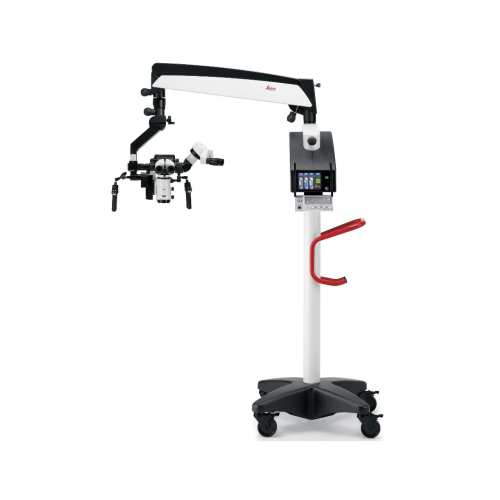
-
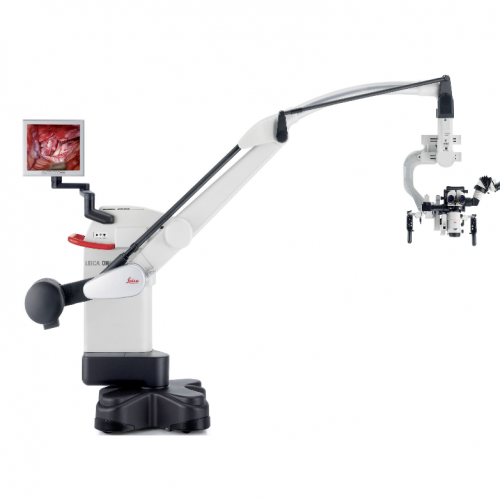 The Leica OH4 surgical microscope provides superior reach, height, and clearance. The Leica OH4 floor stands that moves easily and when the brakes are released, the microscope stabilizes in only 1.5 seconds and remains vibration-free. By integrating new glass, glass coatings, and design parameters, high-resolution APO OptiChrome technology delivers an expanded working distance and greater depth of focus. In combination with the innovative light management systems BrightCare and AutoIris, you can operate and safe light levels and still see more than ever before. The M525 OH4 also offers FL800 and FL400 fluorescence for intraoperative visualization of blood flow and tumour tissue.
The Leica OH4 surgical microscope provides superior reach, height, and clearance. The Leica OH4 floor stands that moves easily and when the brakes are released, the microscope stabilizes in only 1.5 seconds and remains vibration-free. By integrating new glass, glass coatings, and design parameters, high-resolution APO OptiChrome technology delivers an expanded working distance and greater depth of focus. In combination with the innovative light management systems BrightCare and AutoIris, you can operate and safe light levels and still see more than ever before. The M525 OH4 also offers FL800 and FL400 fluorescence for intraoperative visualization of blood flow and tumour tissue. -
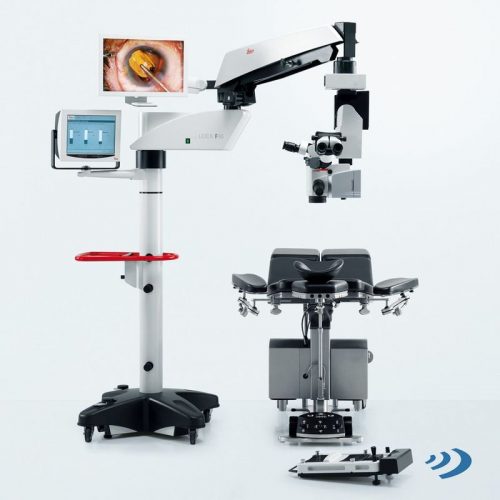 The Leica M822 surgical microscope, with enhanced Red Reflex, meets the highest professional requirements of ophthalmic surgeons to perform cataract surgery more precisely and efficiently.
The Leica M822 surgical microscope, with enhanced Red Reflex, meets the highest professional requirements of ophthalmic surgeons to perform cataract surgery more precisely and efficiently. -
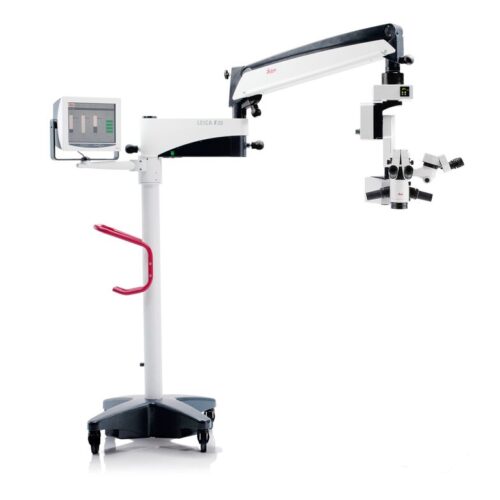 The Leica M844 F40 belongs to the premium class of ophthalmic surgical microscopes and offers optimal solutions particularly for posterior and high-end anterior segment surgery.
The Leica M844 F40 belongs to the premium class of ophthalmic surgical microscopes and offers optimal solutions particularly for posterior and high-end anterior segment surgery. -
 The Proveo 8 ophthalmic microscope provides the exact image you need at each moment of your procedure. Like a precision timepiece every element of the Proveo 8 microscope interconnects and works in perfect synchrony to optimize your view.
The Proveo 8 ophthalmic microscope provides the exact image you need at each moment of your procedure. Like a precision timepiece every element of the Proveo 8 microscope interconnects and works in perfect synchrony to optimize your view. -
 The FLEXACAM C1 can be adapted to your workplace setup - simply connect the camera to your monitor or PC and network. Thanks to the 12 MP CMOS sensor and large dynamic range, fine details and true-to-life colors are a given. adaptable microscope camera solution for a wide variety of samples and applications in industry, life science, forensics, and education .
The FLEXACAM C1 can be adapted to your workplace setup - simply connect the camera to your monitor or PC and network. Thanks to the 12 MP CMOS sensor and large dynamic range, fine details and true-to-life colors are a given. adaptable microscope camera solution for a wide variety of samples and applications in industry, life science, forensics, and education . -
 The Leica DMC2900 is a digital USB 3.0 microscope camera with a 3.1 Megapixel CMOS sensor. It is an ideal tool for brightfield microscopic standard applications in research, life science and industry that often require capturing, documenting, and analyzing color images at optimum visibility of microstructures in little time. The Leica DMC2900 is a digital USB 3.0 microscope
The Leica DMC2900 is a digital USB 3.0 microscope camera with a 3.1 Megapixel CMOS sensor. It is an ideal tool for brightfield microscopic standard applications in research, life science and industry that often require capturing, documenting, and analyzing color images at optimum visibility of microstructures in little time. The Leica DMC2900 is a digital USB 3.0 microscope -
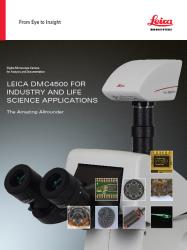 Leica DMC4500 color camera. It has been designed as a versatile, uncomplicated tool that simplifies the imaging process from capture through to processing. It is ideally suited to life science applications such as documenting slides and organisms, pathology or pharmaceutical testing and industrial applications such as quality control and failure analysis.
Leica DMC4500 color camera. It has been designed as a versatile, uncomplicated tool that simplifies the imaging process from capture through to processing. It is ideally suited to life science applications such as documenting slides and organisms, pathology or pharmaceutical testing and industrial applications such as quality control and failure analysis. -
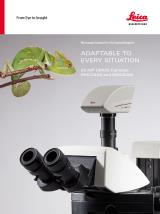 The DMC5400 color CMOS camera offers high frame rate & high-resolution color images even at low magnification. It is optimized to produce fast, high quality images for documentation, evaluation and analysis, for a wide variety of samples and applications in manufacturing and life science research.
The DMC5400 color CMOS camera offers high frame rate & high-resolution color images even at low magnification. It is optimized to produce fast, high quality images for documentation, evaluation and analysis, for a wide variety of samples and applications in manufacturing and life science research. -
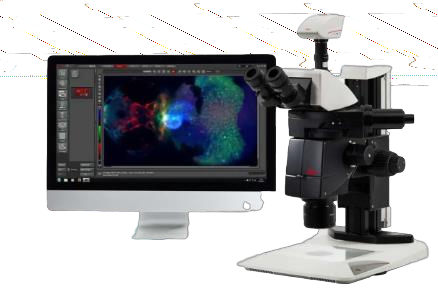 The DMC6200 camera delivers amazing images with intense color detail and contrast - whether at the lowest or highest magnification. Its state-of-the-art CMOS sensor has a 5.86 μm pixel size, 2.3 megapixels sensor resolution, and an astounding dynamic range of 73 dB (4000:1). Achieve an image resolution of up to 20.7 megapixels with cutting-edge pixel shift technology.
The DMC6200 camera delivers amazing images with intense color detail and contrast - whether at the lowest or highest magnification. Its state-of-the-art CMOS sensor has a 5.86 μm pixel size, 2.3 megapixels sensor resolution, and an astounding dynamic range of 73 dB (4000:1). Achieve an image resolution of up to 20.7 megapixels with cutting-edge pixel shift technology. -
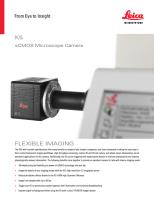 The K5 (grayscale) is ideal for routine fluorescence imaging applications such as immunostaining assays and 3D Cell Culture imaging. Image a wide variety of sample types with the flexibility and power of high 4.2megapixel resolution and fast 40 fps imaging brought to you by the K5.
The K5 (grayscale) is ideal for routine fluorescence imaging applications such as immunostaining assays and 3D Cell Culture imaging. Image a wide variety of sample types with the flexibility and power of high 4.2megapixel resolution and fast 40 fps imaging brought to you by the K5. -
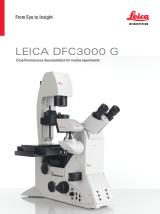 The Leica DFC3000 G is a grayscale USB 3.0 microscope camera for routine fluorescence applications. You will receive crisp images due to its unique passive cooling architecture and its highly sensitive CCD sensor. Correlated pixel double sampling together with a reduction of the ambient temperature of the sensor offers an exceptionally clear and noise -free signal. Its CCD sensor is particularly suitable for low light situations such as fluorescence and will capture even smallest amounts of light.
The Leica DFC3000 G is a grayscale USB 3.0 microscope camera for routine fluorescence applications. You will receive crisp images due to its unique passive cooling architecture and its highly sensitive CCD sensor. Correlated pixel double sampling together with a reduction of the ambient temperature of the sensor offers an exceptionally clear and noise -free signal. Its CCD sensor is particularly suitable for low light situations such as fluorescence and will capture even smallest amounts of light.
